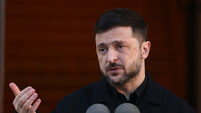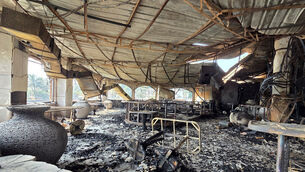Two British airmen missing as US missile downs RAF jet
Two British airmen on a Tornado are missing after they were downed by a US Patriot missile close to the Kuwait border. They were returning from a mission over Iraq in the early hours of yesterday morning.
It was the third air disaster involving British servicemen since the war began, none of which were caused by enemy fire.
Six people were killed when two British Sea King early-warning helicopters collided in mid-air over the Gulf on Saturday.
Another eight personnel from 3 Commando Brigade died when the US Sea Knight transport helicopter they were travelling in crashed in the north Kuwait desert on Friday.
The commander of British forces in the Gulf, Air Marshal Brian Burridge, confirmed one of his planes had been shot down “by mistake”.
But he vowed that relations with the Americans were as strong as ever.
Speaking at Allied Central Command in Qatar, he said: “A military campaign is probably the most intimate alliance you can implement.
“We have two nations who share the risks, share the dangers and share the rewards.
“You develop a bond of trust because you are taking on responsibility for each other’s lives.
“This is very sad but we will put it behind us as quickly as we can in a military sense and carry on to our objective.”
Group Captain Al Lockwood, the spokesman for British forces in the Gulf, said a joint British and US investigation was already under way.
“We will get to the bottom of it to make sure there is no repetition,” he said.
The number of UK soldiers killed by their US allies in the 1991 Gulf War - nine - was the same as the number killed by enemy fire.
The nine died when their Warriors were hit by US tankbuster bombs in broad daylight.
Apart from the probable loss of two lives in the latest incident, it is a major embarrassment for the coalition, after hundreds of millions of pounds have been spent on reducing the chances of friendly fire casualties, including a system known as Identification Friend or Foe (IFF).
In January this year, the commander of the nine British soldiers killed in 1991 accused the Ministry of Defence of “serious negligence” for not introducing IFF quickly enough.
And a year ago the National Audit Office said that, although the MoD had invested £400 million, it was acting too slowly.
It said the system was still not fully compatible with equipment in other NATO countries, including the US.
The system, if fully implemented, should mean that US and British systems would recognise one another and be unable to fire on each other.
The American-built Patriot missile should also have recognised the difference between a plane and a missile, which have different speeds and trajectories.
Patriots were originally designed for use against enemy aircraft but were modified to act as a defence against incoming short-range ballistic missiles.
The one-tonne missile carries a 200lb high-explosive shrapnel warhead. The Patriot missile system has eight launchers, each containing four missiles, all controlled by computer-guided radar.
The missile is launched and guided to the target in three phases. First the guidance system turns the Patriot toward the target as it flies into its radar beam.
Then the computer guides the missile toward the target.
Finally, the Patriot’s internal radar receiver guides it over the final distance toward the target.
During the Gulf War, Patriots were used successfully to shoot down incoming Iraqi Scud or Al-Hussein missiles launched at Israel and Saudi Arabia.
Unlike the Patriot batteries that remained stationary during Operation Desert Storm, the units in the Kuwaiti desert today will actually move over the border with frontline troops.
Patriots have already successfully taken down several Iraqi Scuds and anti-ship missiles fired into Kuwait during the present conflict.













